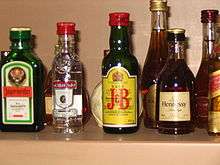Speyer wine bottle

The Speyer wine bottle (or "Römerwein") is a sealed vessel, presumed to contain liquid wine, and so named because it was unearthed from a Roman tomb found near Speyer, Germany. It is the world's "oldest bottle of wine".
History
The Speyer wine bottle most likely holds wine, and was originally found in 1867, in what is now the Rhineland-Palatinate region of Germany, near the town of Speyer, one of the oldest settlements in the area. The artifact has since become known as "the world's oldest existing bottle of wine".[1][2][upper-alpha 1] The bottle has been dated between 325[1] and 350 AD,[4] and is the oldest known unopened bottle of wine in the world.[1][4][5][6] Since its discovery, it has been exhibited at the Wine Museum section of the Historical Museum of the Palatinate in Speyer, always displayed in the same location within the museum.[7] The "Römerwein" is housed in the museum's Tower Room.[8] It is a 1.5-litre (51 US fl oz) glass vessel with amphora-like "shoulders," yellow-green in color, with dolphin-shaped handles.[6][upper-alpha 2]
Discovery
The bottle was discovered during an excavation[9] within a 4th-century AD Roman nobleman's tomb. The tomb contained two sarcophagi, one holding the body of a man and one a woman.[1] One source says the man was a Roman legionnaire and the wine was a provision for his celestial journey.[10] Of the six glass bottles in the woman's sarcophagus and the ten vessels in the man's sarcophagus, only one still contained a liquid. There is a clear liquid in the bottom third, and a mixture similar to rosin above.
Wine preservation
While it has lost its ethanol content, analysis is consistent with at least part of the liquid having been wine.[1] The wine, likely produced in the same region,[5] was diluted with a mixture of herbs.[1] The preservation of the wine is attributed to the large amount of thick olive oil, added to the bottle to seal the wine off from air,[1] along with a hot wax seal.[2][4][5] Petronius (c. 27–66 AD), in his work, Satyricon, writes of plaster sealed bottles, and this one is analogous. The use of glass in the bottle is unusual, however, as typically Roman glass was too fragile to be dependable over time.[6]
While scientists have considered accessing the liquid to further analyze the content, as of 2016 the bottle remained unopened, because of concerns about how the liquid would react when exposed to air.[5][7] The museum's curator, Ludger Tekampe, has stated he has seen no variation in the bottle in the last 25 years.[7] Oenology professor Monika Christmann of Hochschule Geisenheim University has said, "Micro-biologically it is probably not spoiled, but it would not bring joy to the palate."[5]
See also
References
Notes
- ↑ More precisely, the Speyer wine bottle is oldest liquid wine still surviving, in contrast to the oldest known remains of wine (in the form of powdered residue), which date back to 6,000 B.C.[3]
- ↑ The same museum also houses "the oldest wine bottle in Germany that is still completely filled with wine", found in 1913 and bearing a vintage year of 1687 (from the Steinauer Vineyard near Naumburg).
Citations
- 1 2 3 4 5 6 7 "The Roman Wine of Speyer: The oldest Wine of the World that's still liquid". Deutsches Weininstitut. Retrieved 25 April 2014.
- 1 2 Patrick, Bethanne; Thompson, John; Petroski, Henry, Foreword (17 November 2009). "Of Vice & Vines: The Uncommon History of Wine". The Uncommon History of Common Things (Hardcover). Washington, D.C.: National Geographic: 304. ISBN 1426204205. ISBN 978-1426204203. Retrieved 27 April 2014.
- ↑ Dal Piaz, Gregory. "Old wine: An ancient timeline for great old wine". Retrieved 27 April 2014.
- 1 2 3 The Globe and Mail (4 December 2013). Ask A Wine Expert: 101 Things We All Want to Know. Booktango. p. 13. ISBN 978-1-4689-4147-0. Retrieved 25 April 2014.
- 1 2 3 4 5 Hall, Allan (10 December 2011). "Shall We Crack Open the 350AD Vintage? Historians Debate Whether to Open 'World's Oldest Bottle of Wine'". Daily Mail. Retrieved 25 April 2014.
- 1 2 3 Jackson, Ronald S. (30 April 2008). Wine Science: Principles and Applications (3rd ed.). Burlington, MA; London; San Diego: Academic Press/Elsevier. p. 489. ISBN 0123736463. ISBN 978-0123736468. Retrieved 24 April 2014.
- 1 2 3 "Museum scared to open ancient Roman wine". The Local (Germany edition). 9 December 2011. Retrieved 25 April 2014.
- ↑ "Wine Museum, Speyer". Michelin Travel Guide. Michelin. Retrieved 27 April 2014.
- ↑ "Roman Wine in Speyer". Highlight of the Wine Culture. speyer.de. Retrieved 26 April 2014.
- ↑ "The oldest wine in the world". Pfalz. Retrieved 25 April 2014.


